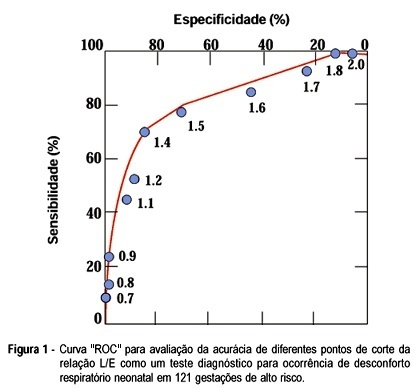Summary
Revista Brasileira de Ginecologia e Obstetrícia. 1998;20(5):253-260
DOI 10.1590/S0100-72031998000500004
Objectives: To determine sensitivity, specificity, positive and negative predictive values of the shake test (Clements) for evaluation of fetal lung maturation in preeclamptic patients. Methods: A prospective study for validation of a diagnostic method was conducted enrolling 163 preeclamptic patients (gestational age between 28-34 weeks) admitted at CAM-IMIP with indication for fetal maturity testing. Preeclampsia diagnosis and classification followed criteria of the National High Blood Pressure Working Group, 1990. Clements' test was performed in three tubes and positive, negative or intermediate results were considered for analysis (related to presence or absence of fetal lung maturity). Accuracy parameters were calculated considering actual incidence of hyaline membrane disease (positive maturity = absent disease) after birth. Hyaline membrane disease was defined by criteria of CLAP, 1978. Statistical analysis was performed using c² test (Epi-Info 6.04b) with a 5% significance level. Results: Intermediate results were considered alternately as positive or negative for analysis. When considered positive, sensitivity was 87.9% and specificity 74.5% with positive and negative predictive values of 8.9.4% and 71.4% respectively - efficiency was 84%. When intermediate results were evaluated as negative, sensitivity decreased to 62% and specificity raised to 89.4% and positive and negative predictive values were 93.5% and 51.2% respectively (efficiency = 70%). False-positive results were rare and usually related to neonatal hypoxia: only 5 (6.5%) of 77 neonates with previous positive Clements had hyaline membrane disease. Nevertheless, false negatives were frequent: almost 40% for negative/intermediate results. Conclusions: Despite its limitations, Clements' test remains a good method for investigation of fetal lung maturation in preeclamptic patients since false positive results are unusual. However sensitivity is low and results have be cautiously analyzed because of elevated rate of false negative results. A good policy is to complement fetal maturity investigation with other tests if a negative result is determined, specially in severe cases when confirmed maturity represents indication for interruption of pregnancy.
Summary
Revista Brasileira de Ginecologia e Obstetrícia. 1998;20(6):315-321
DOI 10.1590/S0100-72031998000600004
The objective was to evaluate the accuracy of the foam stability test, lecithin/sphingomyelin (LS) ratio, presence of phosphatidylglycerol (PG) and lung profile (L/S ratio > 1.7 and PG present simultaneously) in 121 consecutive high-risk gestations at the São Paulo Hospital from January 1990 to January 1995. Delivery occurred within 3 days of fetal lung maturation testing. This is a prospective study in which the sensitivity, specificity, positive (PPV) and negative predictive value (NPV) of all the tests were determined. Neonatal respiratory outcome and amniocentesis results were stratified by gestational age for comparison. The distribution of the studied population according to maternal pathology was diabetes mellitus (48), hypertensive disorders (41), Rh isoimmunization (14) and miscellaneous (18). Respiratory distress (RD) was present in 33 infants (27.2%), mainly in the diabetic group. There was no false negative using lung profile (all patients) and foam stability tests among hypertensive pregnancies (specificity 100%), but there were about 20% to 50% false positives in the other tests. Overall, all four tests had a low PPV: 23% for foam test, 51% for L/S ratio, 63% for PG, 61% for lung profile, and high NPV: 92% for foam test, 88% for L/S ratio, 89% for PG and 100% for lung profile. All tests had less accuracy in the diabetic pregnant women. This study shows that the presence of PG and L/S ratio > 1.7 in the amniotic fluid of high-risk pregnancies confirms maturity with a very low risk to develop RD and that the foam stability test was useful as a first-line test to predict the absence of surfactant-deficient respiratory distress syndrome, particularly in hypertensive pregnant women.
